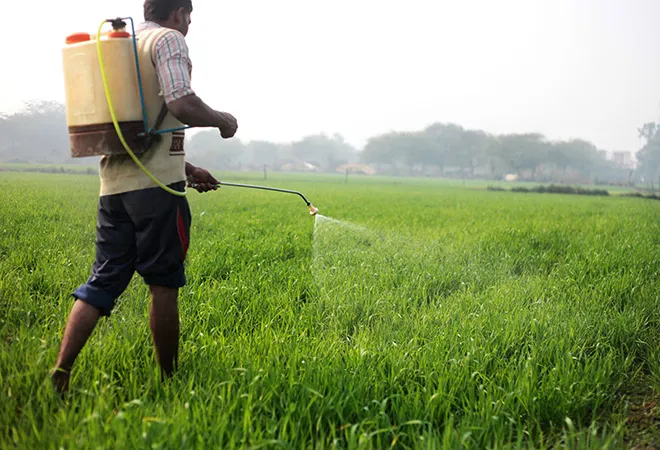
This piece is part of the essay series, Instability in India’s neighbourhood: A multi-perspective analysis
Sri Lanka’s human development and socioeconomic indicators have always been ahead of its South Asian neighbours. Since the end of the civil war in 2009, we witnessed significant progress being made in these indicators such as the Human Development Index, literacy rate, and health-related indicators. According to the World Bank, Sri Lanka has shown a considerable low poverty rate in the South Asian region at 0.77 percent, with India at 13.42 percent, Bangladesh at 15.16 percent, and Pakistan at 5.23 percent. Sri Lanka also aimed to achieve the nationally determined contributions towards reaching sustainable development goals by 2030. This progress can be mainly attributed to the free education and free health services provided to all citizens and the safety net programmes such as the Samurdhi programme. Despite the progress made, with the onset of COVID-19, a trade deficit of over US $3 billion was created, accumulating debt interest that exceeded US $78 million. Foreign reserves declined from US $7,600 million to US $2,311.00 million by May 2022. Export revenue dropped by 3.4 percent from US $1,057 million in March 2022 to US $915.3 million in April 2022. In contrast, inclined expenses on medical and health services went up by 33.1 percent between 2019 to 2021, especially due to COVID-19 pandemic. The loss of foreign exchange from tourism and migrant workers also shook the national economy. Currently, the food inflation has reached an all-time high at 57.4 percent, threatening the food security of the country
Sri Lanka lost its first place ranking in 2017 on the Food Security Index for South Asia dropping to 3rd place by 2021. Food security undoubtedly is a crucial aspect that poses long-term socio-economic impact on the development of a country. Today, Sri Lanka is experiencing food insecurity due to the economic crisis in two ways: First, the escalating human unrest, protests, and long queues for food; second, the extreme dependency on foreign countries, for credit and aid.
However, Sri Lanka pushed through the pandemic with a considerably high production despite changing weather patterns and climatic conditions, therefore, COVID-19 can only be partially held accountable for the food insecurity. The lockdown or other COVID-19 restrictions only marginally affected the agriculture sector. The country was blessed with a remarkable harvest of rice and tea during the pandemic, therefore, the impact would have been marginal.
Political blunders
Rice is the staple food item of the nation which fulfils the caloric requirement of rural poor households to a great extent. Sri Lanka had become self-sufficient in rice since 2010 and was producing an average volume of 900,000 metric tons of fruits and vegetables per year. Thus, the food availability of the country was ensured and was in a range of affordability. However, in the aftermath of the COVID-19 pandemic, followed by the surging economic crisis, the country was deprived of its food security due to two policy blunders. First, in 2016–2017, the fertiliser subsidy given to the farmers was replaced with a coupon system. Previously, for decades, the fertiliser subsidy was extended to the farmer while purchasing NPK fertilisers to give them a good return even if their harvests were bought at a low price. This policy decision aided the low-income earners as rice, fruits, and vegetables became affordable. Unfortunately, following the policy change, farmers traded off the coupons to buy other non-agricultural essentials, thereby, resulting in a drastic decline in crop yield in both yala and maha season—the main crop production seasons in Sri Lanka. This situation was further exacerbated by the extended drought. As a result, the downfall in the production of rice and vegetable was compensated by imports.
Second, the current president, Gotabaya Rajapaksha took an imprudent decision to ban chemical fertilisers and agrochemicals under a slogan of ‘organic agriculture’ in May 2020. However, there was no mechanism or transition strategy to produce sufficient organic manure and to address possible diseases/pest attacks. The country was lacking sufficient organic inputs, technology, and substitutions to cope with the issues in the farmyard. Therefore, the farmers lost their harvest due to poor crop productivity and pest and disease attacks, compelling many to switch to minor jobs in the industrial/construction sector. The impact of this decision is still being experienced amidst skyrocketing inflation making food inaccessible. Although the agrochemical ban was lifted in November 2021, the effects of the ban shall continue to persist in the future. The 35-percent drop in fruit and vegetable and 40-percent drop in paddy production during the period of 2020–2021 are indicative of future decline. Tea, the largest foreign exchange earning crop saw a decline of almost 50 percent as a result.
Gotabaya Rajapaksha took an imprudent decision to ban chemical fertilisers and agrochemicals under a slogan of ‘organic agriculture’ in May 2020. However, there was no mechanism or transition strategy to produce sufficient organic manure and to address possible diseases/pest attacks.
Since independence in 1948, Sri Lanka has suffered the consequences of ad-hoc policies. However, recent policy changes such as undesirable tax cuts, bans, and subsidies coupled with the lack of a national policy, long-term plans, and political commitment for implementation have left the country crippled. Moreover, consumers can no longer afford their food choices. The per capita annual rice consumption dropped from 163 kg per year to 101 kg per year during the period of 2015–2021, prior to the economic crisis, mainly due to the changes in the food habit since wheat flour-based products became popular, a product that was fully imported. In addition, the increased dependence of imported food items was 15.9 percent of the total GDP, which is largely spent on wheat flour, milk powder, lentils, and many other foods dominating the food plates of Sri Lankans have made the insecurity worse. Due to the inflation, wheat flour consumption went down 45 percent since mid-2021. Therefore, the question arises if Sri Lankans could support their new consumption patterns in the face of an economic crisis.
It is evident that the households will move from transitory to chronic food insecurity in the coming months if such economic conditions prevail. Due to mismanagement of resources (land, labour, and capital) and finance, coupled with myopic policy measures such as tax cuts severely affected major economic sectors such as agriculture, fisheries, and trade. Sri Lanka today suffers from a severe energy crisis leading to fuel and gas shortages as well as hours of brownouts. It is now evident that Sri Lanka chose to ignore the International Monetary Fund (IMF) warnings of the crisis and resorted to undesirable measures such as increasing money supply, depreciating the Sri Lankan rupee further, reaching a record value of LKR 364.
As a result of the economic crisis, many small businesses have become non-lucrative, and people have their lost livelihoods. Moreover, food supply chains are disrupted due to the energy crisis. Large amounts of essential food imports have been stopped. Protein-rich food such as eggs, meat, lentils, and milk have become unaffordable to low-income earning groups, putting vulnerable groups such as children, the elderly, and pregnant groups at risk of food and nutritional insecurity. This will further increase the undernutrition rates that already run high—wasting of children under five years in Sri Lanka is among the highest in the world at 15 percent. Moreover, anaemia in women can be expected to increase with the lack of nutrition having serious repercussions on future generations. Certain poor groups such as the plantation workers as well as overlooked vulnerable groups such as hospital patients are at risk of not receiving the required amount of food.
Despite the fact that Sri Lanka is endowed with a favourable climate for agriculture, fertile soil, higher biodiversity, and gene pool, most of the inputs such as seeds, agro-chemicals, machines, and technology are currently being imported. Due to its dependency on imports, Sri Lanka faces frequent global price fluctuations and availability and quality limitations. The financial crisis further disabled the supply of these inputs for cultivation, especially urea. Urea is the only synthetic macronutrient needed for crop growth. Unavailability of urea affects the entire crop production, therefore, leading to crop failures. The prevailing Ukraine and Russia conflict added to the crisis. Ukraine, the largest wheat producer in the world and Russia, the largest urea producer in the world have reduced their supply to the world market, leading to a price increase in the international market. The impact doubled in Sri Lanka due to the exchange rate crisis and the economic crisis. Evidently, the price of a 50-kg urea sack increased by six times from US$16 to US$140 from 2021 to mid-2022 making cultivation a challenge. With food, medicine, fuel, and gas prices increasing consistently and facing severe shortage, the urban communities, particularly the poor are greatly suffering.
It is now evident that Sri Lanka chose to ignore the International Monetary Fund (IMF) warnings of the crisis and resorted to undesirable measures such as increasing money supply, depreciating the Sri Lankan rupee further, reaching a record value of LKR 364.
Responses and remedies
Sri Lanka is urging the farmers to return to paddy cultivation and have also undertaken several pragmatic remedies to increase food production including cultivation of arable lands and urban gardening. As an island nation, Sri Lanka should also look into supporting the adversely affected fishing industry which could be rich protein source to the nation.
Taking immediate action, Sri Lanka has requested food assistance from a South Asian food bank, with the support of South Asian Association for Regional Cooperation (SAARC) and is expecting for 100,000 metric tonnes of food donation or subsidised sales. Sri Lanka has also requested support from the neighbouring countries. India, China, and Japan have already provided financial assistance, credit lines as well as food donations and are expected to provide loans and essential items.
Government expects to increase the Value-Added Tax (VAT) from 8 percent-12 percent as well as corporate tax expecting to increase the government revenue by 65 billion to ease the debt. The government needs to take certain policy changes and decisions to provide a social security mechanism for the low-income group to help them recover from the immediate economic shock in the form of cash as well as donations and alternative opportunities<1> Customised policies and programmes are needed to assist urban and rural poor as their struggles vary. Nutrition security is at stake, therefore, programmes targeting provision of meals for school children, awareness of utilisation, low-cost consumption patterns, gardening and dietary diversity, are essential. The strengthening of distribution channels, alongside improving the use of public transportation, providing financial assistance for growers, linking markets and creating marketing opportunities should be implemented. Lessening the burden on households through concessions on utility bills, moratoriums, etc. can have a high impact on household budgets. Both formal and informal sector need supporting the medium run.
Following such measures could be short-term strategies to combat the surging food crisis. The critical requirements in agriculture including urea and other key inputs need to be prioritised. Provision of credit and loan facilities for fertiliser and seed purchase, partial and full subsidies customized for fertilizer based on the need as well for other agriculture inputs is proposed. A considerable percentage from agro-based export earnings has to be directed to the agricultural sector to purchase necessary inputs. As Sri Lanka is expected to face many hardships in the comings months, international support needs to be extended, both financial and non-financial, to increase agricultural productivity, enhance job opportunities, and labour productivity. The government is also encouraging urban gardening and awareness programmes aimed at food security. Apart from the suggestions for a national agricultural policy, land-use management, upliftment of the living standard of farming families, promotion of value addition from locally available fruits and vegetables, seed production and environmentally friendly fertiliser facilities, technology transfer, research and development on value additions and ways to minimise post-harvest losses are recommended. Further, Sri Lanka’s vulnerability to the effects of climate change will continue to threaten food security and nutrition. Therefore, these precautionary measures and prioritized strategies should be undertaken for Sri Lanka to overcome the grappling issues and emerge as a stronger nation.
<1> These could be in the form of supporting household level gardening and cultivation, job opportunities and entrepreneurial assistance, guaranteed prices for essential food items, given the rising inflation.
The views expressed above belong to the author(s). ORF research and analyses now available on Telegram! Click here to access our curated content — blogs, longforms and interviews.




 PREV
PREV



